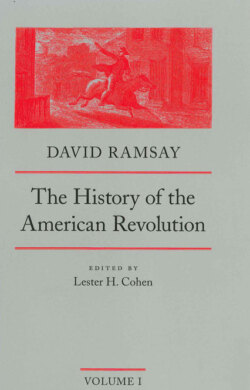Читать книгу The History of the American Revolution - David Ramsay - Страница 9
На сайте Литреса книга снята с продажи.
ОглавлениеEditor’s Note
THIS EDITION OF RAMSAY’S The History of the American Revolution is the first to reprint the original 1789 edition printed by R. Aitken and Son in Philadelphia. That was the only edition that Ramsay actually authorized. The others, including the popular London edition of 1793, printed by John Stockdale, were pirated before the promulgation of effective copyright laws.
Aitken’s and Stockdale’s editions vary only minutely. In numbering the pages, Aitken omitted page numbers 321 and 322 of the first volume, so that the text flows directly from page 320 to page 323. Stockdale did not preserve Aitken’s error; we did, in order to conform to the pagination of the first edition. Aitken also rendered page 32 of volume I as page “13.” We have corrected that error, since it has no bearing on the actual pagination and since preserving it would have no value for modern readers. Stockdale’s copy of Aitken’s edition, like the one we used here, may have contained a few illegible passages. Stockdale must have interpolated at those points and occasionally misread the text. We have stayed with the wording of the original by comparing it with another printing.
Ramsay was substantially correct about Aitken’s “execrable” printing. Aitken’s punctuation is wildly irregular and his spelling idiosyncratic. He transposed letters and abbreviated titles inconsistently and, apparently, according to some inner vision. Thus, we were faced with numerous choices. We have tried here to fulfill the ideal of remaining as faithful to the original text as possible while producing a volume that is accessible to modern readers. We have silently corrected the text where errors were obviously the result of the printer—transposed letters, misspelled words—and where to preserve the errors would have no realistic scholarly or aesthetic value. In a number of instances Ramsay’s punctuation has been modernized. Most of the time this meant removing dashes erratically placed (by today’s standards) and extraneously placed (duplicating a directly preceding or succeeding punctuation mark). In rarer instances, periods and commas were inserted or removed to correct a glaring omission or a usage that strongly clashed with modern conventions of punctuation. As already implied, our policy was to make such alterations in as conservative a manner as possible—and thus a number of the original quirks and errors, which do have the merit of preserving something of the flavor of the first edition, still reside in this one.
We have, in addition, rendered lengthy quotations in block-indented form, rather than run quotation marks down both sides of paragraphs as in the original.
We have preserved the page numbers of the original, which here appear in brackets in the text. We have also preserved Ramsay’s and Aitken’s marginalia, although we have silently corrected dates appearing in the margins where the originals were clearly erroneous and deleted some of the most redundant of the dates that were repeated. We have added an index for the convenience of modern readers and researchers. Four appendices, interspersed between chapters rather than included together at the end of the book, have been kept in the place originally assigned to them by Ramsay and Aitken.
ACKNOWLEDGMENTS
In addition to sharing with me his knowledge and writings on Ramsay, Arthur H. Shaffer graciously read an early version of the introduction and offered useful suggestions. I am currently reviewing Shaffer’s authoritative biography of Ramsay, the manuscript of which arrived unfortunately too late for me to borrow from as liberally as I would have liked. Upon publication, Shaffer’s biography will be as indispensable as Brunhouse’s excellent collection of sources. Linda Levy Peck proved again the value of her friendship and her keen eye for bad writing. She favored the foreword with several readings, helping me to eliminate the gaffes that no longer appear. Dan McInerney and Bruce Kahler, two former Ph.D. students, also read this material and made numerous valuable suggestions. Bill Dennis, Barbara Reynolds, and Chuck Hamilton of Liberty Fund were, as always, a delight to work with. They took a chance on publishing two early American histories—first Mercy Otis Warren’s and then David Ramsay’s—and made the experiences gratifying for me.
In preparing Ramsay’s History for publication, I had the extraordinary experience of coming full circle. At the beginning of my graduate career in 1966, I was blessed by having Page Smith as my mentor and friend; at the end of my teaching career, there was David Ramsay, whom Page introduced to me, along with his passion for the beauty and deceptive simplicity of narrative. I have always identified the two, David Ramsay and Page Smith, no doubt because Page has always exemplified for me the finest spirit of the eighteenth century. If these volumes were mine, rather than Ramsay’s, to dedicate, I would dedicate them with admiration and respect to Page Smith.
L.H.C.
